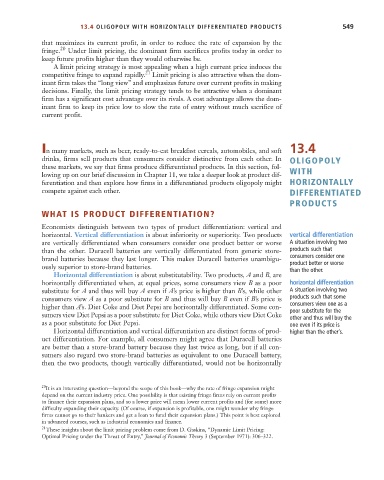Page 575 - Microeconomics, Fourth Edition
P. 575
c13marketstructureandcompetition.qxd 7/30/10 10:44 AM Page 549
13.4 OLIGOPOLY WITH HORIZONTALLY DIFFERENTIATED PRODUCTS 549
that maximizes its current profit, in order to reduce the rate of expansion by the
fringe. 20 Under limit pricing, the dominant firm sacrifices profits today in order to
keep future profits higher than they would otherwise be.
A limit pricing strategy is most appealing when a high current price induces the
competitive fringe to expand rapidly. 21 Limit pricing is also attractive when the dom-
inant firm takes the “long view” and emphasizes future over current profits in making
decisions. Finally, the limit pricing strategy tends to be attractive when a dominant
firm has a significant cost advantage over its rivals. A cost advantage allows the dom-
inant firm to keep its price low to slow the rate of entry without much sacrifice of
current profit.
In many markets, such as beer, ready-to-eat breakfast cereals, automobiles, and soft 13.4
drinks, firms sell products that consumers consider distinctive from each other. In OLIGOPOLY
these markets, we say that firms produce differentiated products. In this section, fol-
lowing up on our brief discussion in Chapter 11, we take a deeper look at product dif- WITH
ferentiation and then explore how firms in a differentiated products oligopoly might HORIZONTALLY
compete against each other. DIFFERENTIATED
PRODUCTS
WHAT IS PRODUCT DIFFERENTIATION?
Economists distinguish between two types of product differentiation: vertical and
horizontal. Vertical differentiation is about inferiority or superiority. Two products vertical differentiation
are vertically differentiated when consumers consider one product better or worse A situation involving two
than the other. Duracell batteries are vertically differentiated from generic store- products such that
brand batteries because they last longer. This makes Duracell batteries unambigu- consumers consider one
ously superior to store-brand batteries. product better or worse
than the other.
Horizontal differentiation is about substitutability. Two products, A and B, are
horizontally differentiated when, at equal prices, some consumers view B as a poor horizontal differentiation
substitute for A and thus will buy A even if A’s price is higher than B’s, while other A situation involving two
consumers view A as a poor substitute for B and thus will buy B even if B’s price is products such that some
higher than A’s. Diet Coke and Diet Pepsi are horizontally differentiated. Some con- consumers view one as a
poor substitute for the
sumers view Diet Pepsi as a poor substitute for Diet Coke, while others view Diet Coke other and thus will buy the
as a poor substitute for Diet Pepsi. one even if its price is
Horizontal differentiation and vertical differentiation are distinct forms of prod- higher than the other’s.
uct differentiation. For example, all consumers might agree that Duracell batteries
are better than a store-brand battery because they last twice as long, but if all con-
sumers also regard two store-brand batteries as equivalent to one Duracell battery,
then the two products, though vertically differentiated, would not be horizontally
20 It is an interesting question—beyond the scope of this book—why the rate of fringe expansion might
depend on the current industry price. One possibility is that existing fringe firms rely on current profits
to finance their expansion plans, and so a lower price will mean lower current profits and (for some) more
difficulty expanding their capacity. (Of course, if expansion is profitable, one might wonder why fringe
firms cannot go to their bankers and get a loan to fund their expansion plans.) This point is best explored
in advanced courses, such as industrial economics and finance.
21 These insights about the limit pricing problem come from D. Gaskins, “Dynamic Limit Pricing:
Optimal Pricing under the Threat of Entry,” Journal of Economic Theory 3 (September 1971): 306–322.

